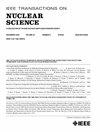Material Properties of Popular Radiation Detection Scintillator Crystals for Optical Physics Transport Modeling in Geant4
IF 1.9
3区 工程技术
Q3 ENGINEERING, ELECTRICAL & ELECTRONIC
引用次数: 0
Abstract
Radiation detection is vital for space, medical imaging, homeland security, and environmental monitoring applications. In the past, the Monte Carlo radiation transport toolkit, Geant4, has been employed to enable the effective development of emerging technologies in these fields. Radiation detectors utilizing scintillator crystals have benefited from Geant4; however, Geant4 optical physics parameters for scintillator crystal modeling are sparse. This work outlines scintillator properties for GAGG:Ce, CLLBC:Ce, BGO, NaI:Tl, and CsI:Tl. These properties were implemented in a detailed silicon photomultiplier (SiPM)-based single-volume scintillation detector simulation platform developed in this work. It was validated by its comparison to experimental measurements. For all five scintillation materials, the platform successfully predicted the spectral features for selected gamma-ray emitting isotopes with energies between 30 keV and 2 MeV. The full-width at half-maximum (FWHM) and normalized cross correlation coefficient (NCCC) between simulated and experimental energy spectra were also compared. The majority of simulated FWHM values reproduced the experimental results within a 2% difference, and the majority of NCCC values demonstrated agreement between the simulated and experimental energy spectra. Discrepancies in these figures of merit were attributed to detector signal-processing electronics modeling and geometry approximations within the detector and surrounding experimental environment.求助全文
约1分钟内获得全文
求助全文
来源期刊

IEEE Transactions on Nuclear Science
工程技术-工程:电子与电气
CiteScore
3.70
自引率
27.80%
发文量
314
审稿时长
6.2 months
期刊介绍:
The IEEE Transactions on Nuclear Science is a publication of the IEEE Nuclear and Plasma Sciences Society. It is viewed as the primary source of technical information in many of the areas it covers. As judged by JCR impact factor, TNS consistently ranks in the top five journals in the category of Nuclear Science & Technology. It has one of the higher immediacy indices, indicating that the information it publishes is viewed as timely, and has a relatively long citation half-life, indicating that the published information also is viewed as valuable for a number of years.
The IEEE Transactions on Nuclear Science is published bimonthly. Its scope includes all aspects of the theory and application of nuclear science and engineering. It focuses on instrumentation for the detection and measurement of ionizing radiation; particle accelerators and their controls; nuclear medicine and its application; effects of radiation on materials, components, and systems; reactor instrumentation and controls; and measurement of radiation in space.
 求助内容:
求助内容: 应助结果提醒方式:
应助结果提醒方式:


